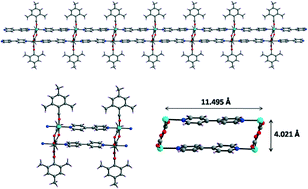Auxiliary ligand-aided tuning of aggregation of transition metal benzoates: isolation of four different types of coordination polymers†
Abstract
Reactions of alkyl-substituted aromatic monocarboxylic acids with first-row transition metal ions in the presence of chelating and bridging N,N-donor ligands produce a variety of discrete and polymeric complexes, depending on the position of the substituent on benzoic acid and the ability of the auxiliary ligand to act as a chelating or a bridging ligand. The eleven different compounds isolated in the present study fall into two different structural types, viz., discrete mono or/dinuclear complexes ([Cu(L1)2(AL1)(H2O)] (1), [Mn(L1)2(AL1)]2 (2) and [Zn(L1)2(AL1)]2 (3)) and polymeric compounds (4–11). The polymeric compounds isolated can further be classified into four different structural types, viz., 1D helical polymers, linear 1D polymeric chains, railroad-like polymers and 2D polymeric sheets. The structure modulation is a result of the combination of the types of substituents on the aryl ring of the benzoic acid and the nature of the auxiliary ligand used. For example, when 1,10-phenanthroline was used as the auxiliary ligand and the carboxylic acid used was 4-tert-butylbenzoic acid, discrete complexes were isolated. However, for the same auxiliary ligand, when 2,4,6-trimethylbenzoic acid was used, a series of 1D helical polymers ([M(L2)2(AL1)(H2O)]n; M = Mn (4), Co (5), Cu (6), and Zn (7)) were obtained. This clearly demonstrates the ability of o,o′-disubstituted benzoic acids to form helical polymers, whereas p-substitution on the aryl ring results in discrete complexes. The reactions of metal acetates with benzoic acid in the presence of 4,4′-bipyridine were found to be sensitive to the ortho substituents on the acid. When two equivalents of 2,4,6-triisopropylbenzoic acid were used, a linear polymer ([Zn(L3)2(AL2)]n (8)) was obtained. The use of either one or two equivalents of 2,4,6-trimethyl benzoic acid invariably leads to the isolation of railroad-like polymers ([M(L2)(OAc)(AL2)]n; M = Mn (9) and Zn (10)) where the rails are bridged by the acetate ligand. Replacing the carboxylic acid by a phosphate diester leads to the isolation of a 2D polymer ([Zn(L4)2(AL2)]n (11)) due to the ability of phosphate to act exclusively as a bridging ligand. In addition to extensive analytical and spectroscopic characterization of the products, the solid-state structures of all the new compounds were determined using single-crystal X-ray diffraction.


 Please wait while we load your content...
Please wait while we load your content...